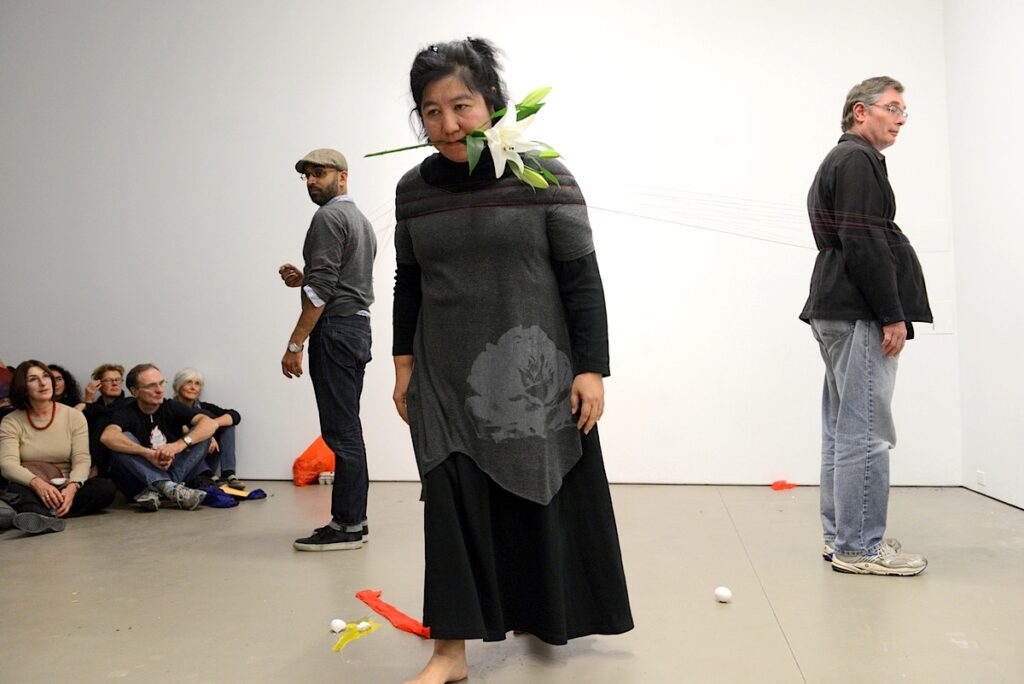By Randy Gledhill
There are several common trends and threads being employed by many artists in the current ‘performance festival’ format and genre. Surprisingly artists, offered free reign to present themselves in any way they wish, usually choose a formal gallery setting and time slot of about 30 minutes to parade their dog-and-pony show to a supportive audience. This is a convenient invention, both to the artist and the over-extended, dedicated festival impresarios, organizers, support crew and volunteers – that is perhaps diametrically opposed to the often referenced historical performance legends, which, as the story goes, perhaps lasted from a few brief seconds to a year or more in duration and took place mostly in non-negotiable contexts. Indeed, according to Robert Filliou, an action might last a lifetime.
Although there are still (thankfully) no rules of engagement, there are certain tropes that we see increasingly being employed. One strategy is to invite participation (participatory art?) from hapless audience attendees, to somehow physically engage and become conspirator to the artist’s intention and devise. This is a slippery slope. If the attempt becomes superficial, forced or even slightly tense, it is doomed to fail.

Last night, we were blessed with another version of how to work with people, through Nopawan Sirivejkul. This artist’s performative engagement hinges entirely on who she is and how she navigates her own private life. Nopawan functions in her sphere in Bangkok and Thailand as a kind of grounded earth-mother to a cast of wild and crazy Thai militants, radicals and artists. She is the glue that binds the Asiatopia festival. In that role, she endlessly gives her love, support and guidance to Asiatopia’s extended family.
For her 7A*11D opportunity, Nopawan started slowly, walking around her zone to finally possess it. She placed three strips of red cloth on the floor and then held high an oversize wine glass, which she then also placed on the floor. She stretched the first red strip between her extended hands, facing into the corner, demonstrating its elastic, translucent nature..
Then came the eggs. Rolls the first across the floor. Throws the second against the gallery wall. Rolls the third into the audience. Places the next in the glass and drops thick red paint over it. She holds up the glass and swirls the viscose red paint around until the egg and glass interior are coated, then gifts it to someone sitting.
She chooses someone to join her to put the next mesh strip over their hand and her hand to stretch. Ftttt. The cloth extends to limit then collapses. She places another egg into the third cloth and engages a volunteer in the dangerous game of rolling an egg between their hands in the cloth tube. Eventually the egg falls. Splat.
Nopawan next takes a length of red thread from a spool and offers one end to someone to put in their mouth. She puts the other end in hers, then, like Lady and the Tramp, they mutually chew towards a kiss.
She selects two very different men and poses them about eight feet apart, then stretches many layers of thread from the spool around them. Holding the stalk of a white lily in her mouth, she walks between them, breaking the threads.
Nopawan’s gentle, centred presence, her humanistic connection to the people she is addressing, her ability to slow us down, illuminates.
I am again tasked to search a deeper meaning, an intention, an essence to the action. What, beyond some simple props and gestures is she describing? The Thai aesthetic code is so different than mine. The minimalism, elegance and symbols confound me (as has much of my experience in Thailand). What remains is Nopawan’s simple gestures, her playfulness in negotiating her intent and territory with others and her humanistic generosity to her public. Perhaps that is enough.
R
